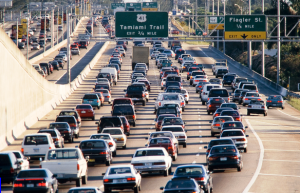
Ford, HP Analyze Commuting Patterns

American drivers logged a record number of miles in April, Reuters reported this week, citing U.S. government data showing that an increase in road travel over the last year is continuing.
The U.S. Federal Highway Administration said Americans logged 267.9 billion miles on U.S. roads in April, the highest monthly total since 1990 and up 3.9 percent from a year earlier.
With that as backdrop, Ford Motor Co. and Hewlett-Packard conducted an experiment designed to discern patterns in HP workers’ commuting habits. The thinking is that the dataset could reveal “commuting commonalities” that could help manage corporate fleets and personal transportation services while offering recommendations for individual drivers.
More commuters seem to be driving to work these days. In regions like Washington, D.C, mass transit ridership is down. Part of the reason is more teleworking, but the car has also become an office for some workers.
Ford used HP’s Haven big data platform and its Vertica analytics engine to discern driving patterns among the giant IT vendor’s workforce. Ford said it wanted to study how driving habits are changing as a way of reducing fuel and maintenance costs. The carmaker also said the cost of corporate fleets could be lowered through national purchasing contacts designed to boost utilization and reduce maintenance.
The data could also be used to promote carpooling, Ford researchers said.
Stop-and-go city driving (34 percent) was the largest percentage of trips recorded in the fleet insights experiment, followed by freeway driving (21 percent), non-rush-hour (29 percent) and rush-hour driving (16 percent).
The study also appears to have provided some valuable marketing data for a certain Seattle-based retailer. “Regardless of location, most drivers visited the same national coffee house,” the fleet researchers found. Driver also tended to refuel with the same brand of gasoline.
Another finding was that corporate road warriors often leave vehicles unused for days in expensive airport parking lots. That finding led to the obvious conclusion that other workers could better utilized these vehicles. Finally, 70 percent of trips took place during weekdays, with an average trip distance of 13 miles or less.
The experiment used HP fleet vehicles equipped with wireless sensors plugged into each vehicle. Ford data scientists used the HP Vertica analytics engine, part of the HP Haven platform, to discern patterns and multiple facets of fleet activity. Drivers were able to access data, if needed, using a smartphone app to recall trip details.
HP rolled out a Haven predictive analytics package in February as a way to accelerate machine learning and statistical analysis of evolving data volumes. HP upgraded it analytics engine last November with its Vertica for SQL on Hadoop platform designed to provide a pathway to data residing on Apache data lakes as well as other Hadoop distributions.
The Ford/HP fleet experiment included data collected from nearly 100 vehicles. Data collection began in late 2014 and ended earlier this month. The partners said data analysis would continue through the end of 2015.
Recent items:
Big Data Helps Drive Transportation Planning



























